This one small, fragile planet cannot withstand the constant and indefinite assault of “progress” wrought upon it by a technology-crazed, linear, monetary-based culture. As many writers and philosophers have said more eloquently than I: the monetizing and compartmentalizing of the world and nature by humans has fostered a separation and a duality that can have nothing but dire consequences. Simply put, the Earth’s resources will not last forever, and if humans continue using them at will, growing in population by leaps and bounds, measuring life on a linear scale of consumption and the acquisition of “stuff”, and viewing themselves a part from (as opposed to a part of) nature, these resources won’t last long at all.
Technology itself is not inherently evil (evil is a man-made construct, after all), but the unrealistic, almost religious (organized, of course) devotion to it as the answer to all of humanity’s problems is as dangerous as hordes of people blindly worshiping a fictitious thirty something Jewish guy who supposedly rose from the dead. Both are a dark path to complacency, wanton destruction, and irresponsible behavior. Man and other animals have always “used nature” to survive, but there is a difference between cutting down a tree to build a shelter necessary for survival and the clear cutting of entire forests to make more things for consumption. But this is the world humans have made for themselves and it is the world we must survive in. Assuming humanity can revert back to a pre-industrial or pre-ANYTHING time is as unrealistic as the messianic view of technology. As humans we must work and collect paper because everything has been monetized; we must purchase shelter and food necessary for survival. Technology can’t, nor should it, be eradicated, but the way humans perceive it and use it can be altered into a more holistic view--one in which humans act in accordance with nature versus acting against it. The Earth is not something to be conquered, for to conquer it is to destroy it, thus destroying ourselves.
These are not ground-breaking new thoughts: Buddhists, Romantics, artists, philosophers, transcendentalists, and Outsiders (to name a few) have been expressing them for centuries. Four of these artists with special significance given their existence in the contemporary world are four French-Canadian men: Denis "Snake" Bélanger, Denis "Piggy" D'Amour, Jean-Yves "Blacky" Thériault, and Michel "Away" Langevin. These four sonic artists are collectively known as Voivod; a band whose progressive brand of dystopic thrash metal realized the shortcomings of the “technological utopia” and over a span of five concept albums from 1984-1989 illuminated its negative effects on humanity and the world, all the while recognizing it as now an inextricable part of human life and for the double-edged sword that it is. As Michel Langevin said in a 1989 interview: “You can’t really be against technology, it would be like being anti-breathing or something. When we did the Killing Technology album a lot of things happened at that time like the Chernobyl accident, the Challenger explosion, and the Star Wars project and those things. We are into high technology; computers, space ships and all that, but we didn’t like the underside of it, like sometimes the political side of it or more like Man's inability to deal with high technology.” (Keep in mind English is his second language). Voivod achieve this in three distinct styles, each representing an epoch in humanity’s relationship with technology: War and Pain and Rrröööaaarrr...!!! represent the modern to contemporary age (which I’ll define roughly as World War I to the present) where rampant techno lust rears its ugly head in violence and the mechanization of humanity; Killing Technology and Dimension Hatröss takes this mechanized dystopia further and become more exploratory and intuitive. Here life and machine, the organic and inorganic have blended into one, and those aforementioned explorers of modes beyond the status quo are alienated by said status. Finally, with Nothingface, the ultimate doom of a society blinded by technology is realized: humans have become completely alienated, nothings -- an end to which separation from the natural will lead. These are fluid epochs without set boundaries and all three of them exhibit themselves in some form as of my writing this in the winter of 2009.
Arvida, Québec
Voivod hail from the small Québec city of Jonquière, population 55,000 (as of 2001). Jonquière, much like my current place of residence, is a city built of manufacturing -- although Jonquière remains and industrial center. The city’s initial growth came from the construction of of pulp and paper mills in the 1900s. In the 1920s the world’s largest aluminum plant was built in nearby Arvida. To supply the plant, a hydroelectric station was built at Shipshaw in 1942 -- the largest in the world at that time. In 1975, Jonquière, Arvida, and Kénogami were joined into the single city of Jonquière.

Aluminum Smelter
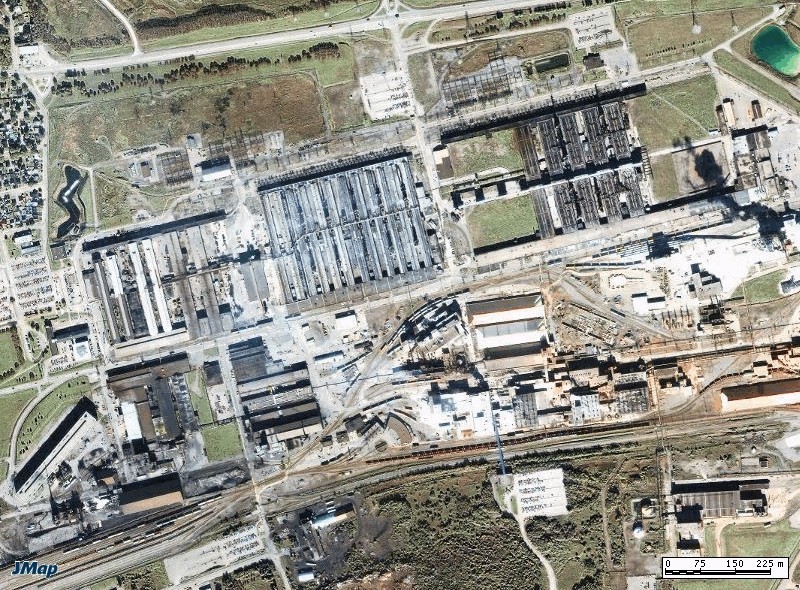
Arvida Smelter
Growing up in the shadow of industry undoubtedly had an affect on the members of the group in their formative years. The name “Voivod” refers to a character created by drummer Michel Langevin when he was 9 or 10 years old. He created not only a character, but an entire universe where the Voivod is the prototypical Outsider anti-hero. Described as a “vampire lord in a post-nuclear age” the Voivod, when looked at through the lens of humanity’s relationship with technology, is also an “everyman” of sorts. This universe, the Voivod, and the land of Morgoth would see a more tangible existence in his later years as they became the foundation for the band the would ultimately be named after the hero.

It is impossible to go into full detail of the concepts of each particular album for a few reasons: it would take thousands of words, excellent expositions on them already exist, and lastly, the concept of a particular album isn’t as important to this essay as the “big picture” the five albums present as a whole. Some background information is necessary, however, in order to understand this big picture.
Voivod’s debut succinctly titled War and Pain was released, maybe not accidentally, in 1984. The Voivod finds himself after a nuclear war. A maimed creature of flesh and bone, he and his tribe are bent of destruction. The human-ness of the Voivod is evident in his make-up and hell bent destroyers serve as chilling reminders of the technological violence of Mankind. The blistering thrash assault is fitting aural accompaniment to such a concept, and along with the lyrics and cover art, add to the ultimately “human” nature of the album.
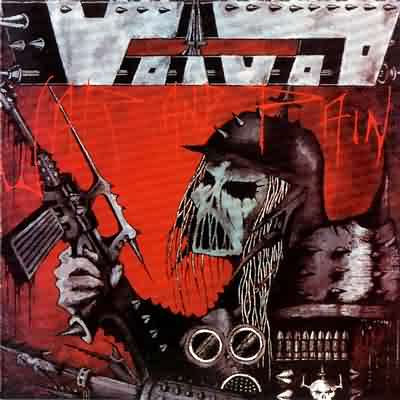
Though disfigured, the gun-wielding, Prussian helmeted Voivod has undeniably humanoid features. His anatomy his anthropomorphic and he’s carrying a gas mask signifying that, despite his supposed invincibility, he is still vulnerable like humans despite their false feeling of superiority over nature. The logo itself is a no nonsense bit of thick spiked steel, again pointing to the earthly aura: steel and spikes in this world are still effective weapons.
Two lyrical excerpts serve to highlight the Voivod’s perception of himself and his outlook on other survivors on Morgoth:
“I'm a nuclear creature
For atomic fight
Come with me in my spider line
In the black hole of the night
Your visit is short today
Don't worry in the terror you stay
And if you don't trust me
I'll chop your body to eat “
-”Voivod”
“Black flag is on my mast
The cannons creep
In your desert to kill
And no defense, no forces
You're the bloodlust victims
In the smoke of combat
No gods gives you the guts.”
-”War and Pain”
It’s important to keep in mind here that the Voivod at this point has a perception of himself as an individual. He is conscious of the fact that he is a nuclear creature, meaning a product of a technological age, and exerts dominance over other creatures through the quenching of his incessant bloodlust. Again, the use of blood keeps this album grounded in the physical, perceivable reality.
With Rrröööaaarrr...!!!, the human element begins to fade and mechinization and more developed technology begins to take control. After a series of nuclear wars, Voivod becomes a “new-age biochemical war machine” with more advanced, fearsome weaponry: Korgull the Exterminator. Korgull spends his time patrolling prisoners and exterminating those who would seek to escape. A look at the cover shows the Voivod looking more mechanical, a skinless Terminator, at the helm of the roaring machine of death. Similarly, the logo has become more “futuristic” to look more like an extension of the machine than a solid slab of metal.
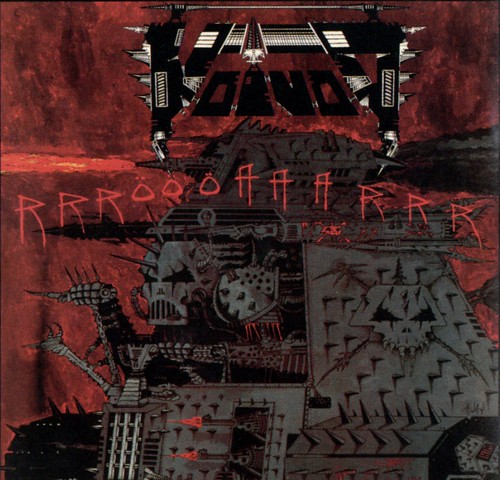
Like the cover, the lyrics have shifted into a more mechanical world; a world less under human control and more under the control of the machines they’ve constructed:
“If you need the horrors of war
See Korgull
The nebulous prowler will come to
Take you and exterminate your life “
-”Korgüll the Exterminator”
However, there is still a human element prevalent as the Voivod is still driven by the urge to kill, only this time in a more sophisticated and “progressive” fashion. Think the brutality and wanton destruction delivered by the first machine guns in World War I or the carpet bombing of World War II versus that scientific wonder of the Second World War -- the atomic bomb.
“Tonite we celebrate
War and our victory
All possessed by the death
To take the force by the blood
Raise your hands for the final slaughter
High pressure marching like
A robot from nowhere
Mutilation we're out to
Conquer all the planet
Creeping weapons see the
Fire blows the sky
Invasion don't stop the
Pressure of pain “
-”To the Death”
And so ends a chapter in the journey of the Voivod.
The middle period of Voivod begins with the more progressive Killing Technology. The Voivod is no longer a planet-roving human, he has become a space traveling cyborg/human. The transformation from human to machine is almost complete, symbolized also by the destruction of Morgoth. With this more complex story comes more complex music and lyrics to fit the new world of the Voivod. Even physically the Voivod has become more complex. His depiction on the cover shows he has completely shed any human likeness and now appears as a robotic spider/cephalopod seated at the controls of his spaceship.
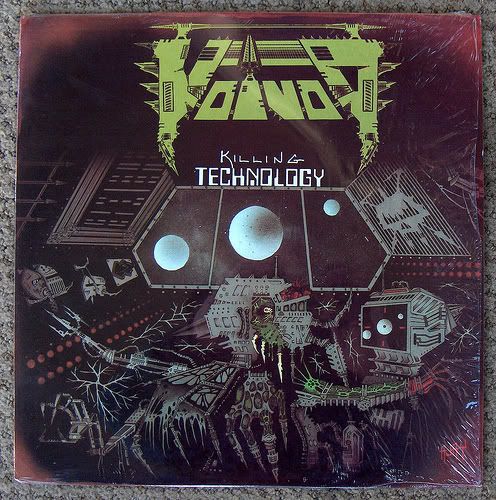
The album was released during the time of the “Star Wars” missle defense system and encroaching technological control. That Voivod (the band) felt strongly about these subjects is evident in their working it into the conceptual storyline. The lyrics show how they viewed these space weapons as an example of human’s inability to deal with/control high technology:
“This sphere is a bad place to live
Growing technology
Fooling technology
Killing technology!!!
The star wars have started up
The new invention is coming out
Making a spider web over the atmosphere
To make them sure that we can't get out of here
Computers controlling your functions
Seems like we got electronic alienation “
-”Killing Technology”
In this sense “Killing Technology” can be taken two ways: the new killing power of the Voivod (and the real world), and real life urge to stifle such dangerous technology from ensnaring the planet (note the use of the word “atmosphere” -- Voivod are aware of the consequences to the planet) and completely alienating people by taking away what little of humanity is left of them.
On a similar wavelength, the tyrannical control of the world shapers is made evident in “Forgotten in Space” and its prison ship to house those deemed hostile to the status quo:
“All systems go !!
The jailship is flying high
From the ground, to out of sight
They pay their crimes, locked inside
Where they go, the judge knows
They did to many murders
Then fell into the crater
They made too many speeches
Against what the people believe
Getting the no limit sentence
For them it's the last stop “
-”Forgotten in Space”
Whatever shred of humanity left on Killing Technology had been sufficiently dismantled by the release of Dimension Hatröss in 1988. On the cover the Voivod is nothing more than a bizarre hockey mask of a head atop a large cube. His head is open with a syringe either injecting what I’d imagine to be some sort of mind control substance or sucking out the last of his personality, making the transformation from man to machine complete.
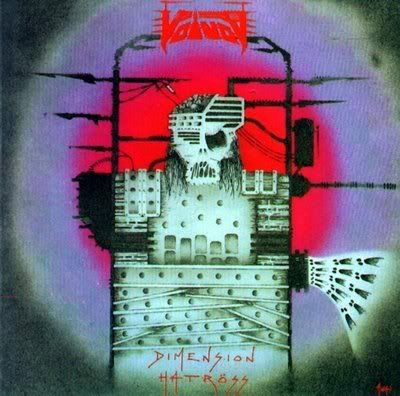
This album features this nightmarish Voivod seeking to explore another dimension. The liner notes sum up its journey: "Inside a giant particle accelerator, a beam of protons traveling at near the speed of light meets a beam of antiprotons moving equally fast in the opposite direction. The protons and mirror-image antiprotons annihilate each other, creating the fiery chaos of a parallel microgalaxy. Experiment one complete, the 'Voivod' goes into that new dimension, meeting different civilisations and psychic entities, extracting knowledge and energy in the eight programs of this project called: Dimension Hatross.”
This is an infinitely more complex undertaking than all previous releases and the lyrics and music reflect these new intergalactic boundaries. Better production makes for a more rewarding experience, allowing the listener to become fully absorbed in the odd harmonies and off-kilter, yet still relentless compositions. Piggy’s guitar work reaches new levels of dissonance stressing the alienation felt by the Voivod and those member of our own society with more active brains:
“I've passed the entry of the system
They taught me with an anthem
It seems like I'm one of them
A kind of people I can't describe
They got a number between their eyes
Identity has been commanded
Subconscious has recorded
The orders from the big head
I'm now a part of this machine
Supervised by the telescreen “
-”Technocratic Manipulators”
The Voivod has enetered a world of automatons, created and controlled by the machine. Upon leaving this new dimension to return “home” the hope of humanity returns. Speaking in the first person, the Voivod refers to his bones and soul going home, could this be one putting his faith in the saving power of technology? One who has given up? One who wants to simply exist?
“The final process
Hard and so complex
Reverse the motion
Adding some tension
Setting the machine
Awaiting to leave
My bones and my soul
On my way back home
Have a look behind
Nothing more to find....”
-”Cosmic Drama”
The answer comes with the final album in the conceptual string, 1989s Nothingface. Despite the terrible late 90s nu-metal title (which can be forgiven because a) there was no nu-metal and b) it is the perfect title for the album), Nothingface is even more introspective than Dimension.
Nothingface was released after singing a three album deal with MCA records. As a result the production is completely “pro” and the intensity is more restrained than previous albums. It is still most definitely an adventurous album, however, and the lack of intensity allowed the group to explore more subdued arrangements which complimented the more cerebral lyrics and concept of this final piece in the puzzle.
The Voivod, completely alienated from the world, retreats into the caverns of his own mind. More humanoid in appearance, the Voivod resumes his “everyman” role as a faceless, anonymous nothing. The jarring images around his empty face appear to be projections of his own mind: the hanging human, the carnival-esque birdman (alienation, Kafka’s Gregor Samsa), and a prison.
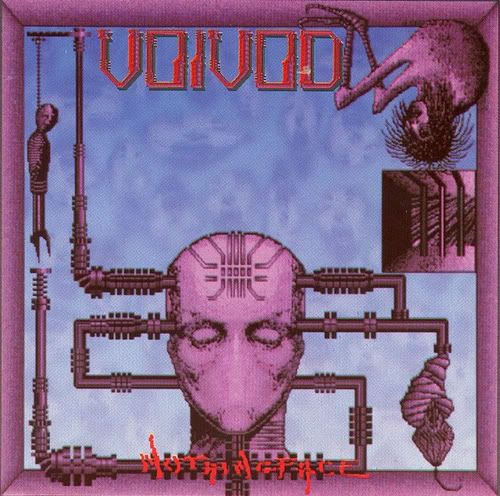
His original personality destroyed, the Voivod attempts to create others, but they all fall short. He is a completely alienated character with no shred of his original self left, hence a “Nothingface.”
“Please no
Too late for S.O.S.
Mute island, fish-eye view
Circling the border line
No resource, no rescue
I'm stranded, I'm otherwise
The error is perfect
Like this sub-effect
Of my mind...my mind”
-”Sub-Effect”
And with the closing of “Sub-Effect” so ends the Voivod. The follow-up to Nothingface was the largely underwhelming Angel Rat, which abandoned not only the Voivod concept, but also most things made Voivod Voivod. But the first five albums, especially when viewed as a whole, are truly intelligent, original, thought-provoking pieces of music that accomplishes what all great metal and art seeks to do: transcend the individual and view the world "from the outside" in order to foster a better understanding of it.
-Zach
NOTE: Excellent bios on voivodfan.com and voivod.net were used as references in the condensing of the actual conceptual storyline of the 5 albums.
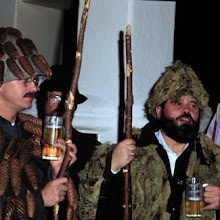
No comments:
Post a Comment